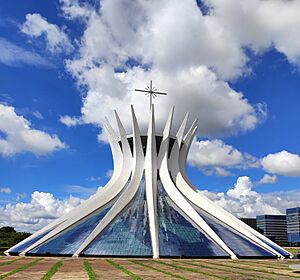Cathedral of Brasília facts for kids
Quick facts for kids Metropolitan Cathedral of Our Lady of AparecidaCatedral Metropolitana Nossa Senhora Aparecida |
|
|---|---|
 |
|
| Religion | |
| Affiliation | Roman Catholic |
| District | Archdiocese of Brasília |
| Ecclesiastical or organizational status | Cathedral |
| Location | |
| Location | Brasília, Brazil |
| Architecture | |
| Architect(s) | Oscar Niemeyer |
| Architectural type | Church |
| Architectural style | Modernist |
| Groundbreaking | September 12, 1958 |
| Completed | May 31, 1970 |
| Capacity | 4000 |
The Cathedral of Brasília is a famous Catholic church in Brasília, Brazil. It's also known as the Metropolitan Cathedral of Brasília. This amazing building is the main church for the Catholic community in Brasília.
A famous Brazilian architect named Oscar Niemeyer designed the cathedral. Another Brazilian engineer, Joaquim Cardozo, helped build its structure. The cathedral was finished and officially opened on May 31, 1970.
Contents
What Makes the Cathedral Special?
The Cathedral of Brasília has a very unique shape. It is a hyperboloid structure, which means it curves inward and then outward. It is built from 16 large concrete pillars. Each of these pillars weighs about 90 tons!
Outside the Cathedral
Outside the cathedral, you will see four tall bronze sculptures. They are about 2.5 meters (8 feet) tall. These sculptures represent the four Evangelists from the Bible. Alfredo Ceschiatti and Dante Croce created them in 1968.
To the right of the entrance, there is a 20-meter (65-foot) tall bell tower. It holds four large bells. These bells were a gift from Spanish people living in Brazil. They were made in a place called Miranda de Ebro.
At the entrance, there is also a special pillar. It shows pictures from the life of Mary, who was the mother of Jesus. These pictures were painted by an artist named Athos.
A wide, shallow pool of water surrounds the cathedral's roof. This pool is 12 meters (39 feet) wide and 40 centimeters (16 inches) deep. It helps keep the building cool. Visitors walk under this pool when they enter the cathedral.
Inside the Cathedral
The cathedral can hold up to 4,000 people inside. When you enter, you walk through a tunnel. Then, you come out into a bright space with a glass roof.
The outer roof has 16 pieces of fiberglass. Each piece is 10 meters (33 feet) wide at the bottom and 30 meters (98 feet) long. These pieces fit between the concrete pillars.
Below the roof, there is a huge stained glass artwork. It covers about 2,000 square meters (21,500 square feet). Marianne Peretti created this beautiful glass art in 1990. It has shades of blue, green, white, and brown.
Above the main area, called the nave, you can see three angel sculptures. They hang from steel cables. Alfredo Ceschiatti and Dante Croce made these angels in 1970. The smallest angel is 2.22 meters (7.3 feet) long and weighs 100 kg (220 lbs). The middle one is 3.4 meters (11 feet) long and weighs 200 kg (440 lbs). The largest angel is 4.25 meters (13.9 feet) long and weighs 300 kg (660 lbs).
The main altar was a gift from Pope Paul VI. There is also an image of the patron saint, Our Lady of Aparecida. This image is a copy of the original one found in Aparecida, São Paulo. The "Way of the Cross" artwork was created by Di Cavalcanti.
Under the main altar, there is a small chapel. You can reach it by walking down steps from either side of the altar.
Other Parts of the Cathedral
The oval-shaped baptistery is to the left of the entrance. You can enter it from inside the cathedral or by a spiral staircase from the plaza outside. The walls of the baptistery are covered with ceramic tiles. These tiles were painted in 1977 by Athos Bulcão.
Offices for the Archdiocese of Brasília were finished in 2007. This 3,000 square meter (32,000 square feet) building is next to the cathedral. It connects directly to the cathedral through an underground passage.
History of the Cathedral
The first stone for the cathedral was placed on September 15, 1958. The main structure was finished on April 21, 1960. At that time, only the roof structure could be seen above the ground.
When President Juscelino Kubitschek's time in office ended, work on many buildings in Brasília slowed down. The cathedral was eventually given to the Catholic Church to finish. It was officially blessed on October 12, 1968, even though it still didn't have a roof. Cardinal D. Eugenio Salles officially opened it on May 31, 1970.
The oval baptistery was opened on October 5, 1977. On July 15, 1990, the cathedral was declared an important national historic and artistic monument.
Today, about 1,000,000 people visit the cathedral every year.
Recent Renovations
To celebrate Brasília's 50th anniversary, major renovations began on April 21, 2012. These updates aimed to repair the building and its systems. They also fixed problems with the roof.
The glass on the outside of the cathedral was replaced. The original stained glass by Marianne Peretti was made of handmade glass, which meant it had different thicknesses. This was replaced with new, uniform glass. This new glass was cut and put together in Brazil, using glass made in Germany.
Besides roof repairs, all the marble surfaces were polished. The concrete was repaired and painted. The angel sculptures inside were cleaned and put back in place. The bell mechanisms were also replaced. The cathedral stayed open to visitors during these renovations.


